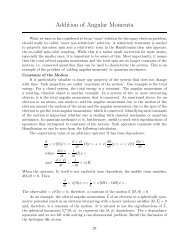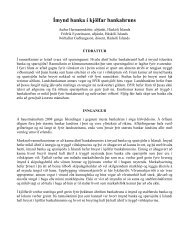The Role of Violent Video Game Content in
The Role of Violent Video Game Content in
The Role of Violent Video Game Content in
Create successful ePaper yourself
Turn your PDF publications into a flip-book with our unique Google optimized e-Paper software.
Olson et al. / <strong>Violent</strong> <strong>Video</strong> <strong>Game</strong>s and Adolescent Boys 59<br />
new game controllers allow an <strong>in</strong>creas<strong>in</strong>g amount <strong>of</strong> physical <strong>in</strong>teraction.<br />
<strong>The</strong> potential l<strong>in</strong>k between violent video games and catharsis merits further<br />
exploration.<br />
<strong>Video</strong> game play may serve particular needs <strong>of</strong> adolescent boys with<br />
regard to aggression and socialization. In this period <strong>of</strong> development, boys<br />
use rough-and-tumble play to explore aggression, establish<strong>in</strong>g peer status<br />
by focus<strong>in</strong>g on dom<strong>in</strong>ance rather than caus<strong>in</strong>g physical harm to participants<br />
(Pellegr<strong>in</strong>i, 2003; Pellegr<strong>in</strong>i & Smith, 1998). It is possible that adolescent<br />
boys achieve some <strong>of</strong> these goals through their video game play. Rather<br />
than encourag<strong>in</strong>g aggressive or violent behavior, video game play may help<br />
adolescent boys consider issues <strong>of</strong> war, violence, and death (Gelfond &<br />
Salonius-Pasternak, 2005). As with physical activity play, some adolescents<br />
may engage with video games <strong>in</strong> a dysfunctional manner.<br />
Adolescents’ Perspectives on <strong>Video</strong> <strong>Game</strong> Play<br />
Our understand<strong>in</strong>g <strong>of</strong> these complex relations, as well as any policy or<br />
legislation that may be implemented, should be <strong>in</strong>formed by adolescents’<br />
own perspectives on their video game play. This <strong>in</strong>cludes recogniz<strong>in</strong>g the<br />
personal, social, and emotional goals boys have for game play; their perceptions<br />
<strong>of</strong> game characters and actions; and the context <strong>of</strong> game play<br />
(Sherry, 2001; Williams, 2005). To date, no published studies have exam<strong>in</strong>ed<br />
young adolescents’ descriptions <strong>of</strong> why they play video games, what<br />
leads them to choose games with violent content, and how they perceive the<br />
<strong>in</strong>fluence <strong>of</strong> games on themselves and their peers. To beg<strong>in</strong> address<strong>in</strong>g this<br />
gap, we conducted focus groups with young adolescent boys.<br />
We chose to focus on young adolescents for several reasons. <strong>The</strong>y may be<br />
more vulnerable to the <strong>in</strong>fluence <strong>of</strong> violent content dur<strong>in</strong>g this stage <strong>of</strong> cognitive,<br />
emotional, social, and neurological development (Kirsh, 2003). <strong>The</strong>y are<br />
more likely to engage <strong>in</strong> risky behavior, especially with peers, and less able to<br />
assess the consequences <strong>of</strong> those behaviors (Gardner & Ste<strong>in</strong>berg, 2005). <strong>The</strong><br />
potential effects <strong>of</strong> game violence on aggressive behavior is a central concern,<br />
and the prevalence <strong>of</strong> externaliz<strong>in</strong>g problems tends to peak <strong>in</strong> midadolescence<br />
(Ste<strong>in</strong>berg & Morris, 2001). F<strong>in</strong>ally, on a practical level, their activities are less<br />
subject to adult oversight than those <strong>of</strong> younger children.<br />
<strong>The</strong> current study was limited to boys. Boys are more likely than girls to<br />
play video games <strong>in</strong> general and action or combat games <strong>in</strong> particular; they are<br />
also far more likely to play games <strong>in</strong> the presence <strong>of</strong> multiple peers (Olson<br />
et al., 2007). Physically aggressive behavior is more common among boys<br />
Downloaded from<br />
http://jar.sagepub.com at Iceland Telecom on February 16, 2009

















